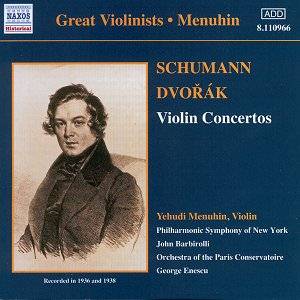The first thing to notice about this latest release
in the Naxos ĎGreat Violinistsí series is the cover portrait. Not, as
expected, that of the ostensible hero of the disc, Yehudi Menuhin, unlike
all the others in this and the allied Great Pianists series that I have
seen where the soloist is dignified with a picture. This CD instead
features Kriehuberís 1839 portrait of Schumann. Is Menuhin still too
much our contemporary, too newly dead, or is this a new Art Work aesthetic
from Naxos?
Whatever the reason here we have two recordings from
Menuhinís golden youth Ė the DvořŠk
recorded when he was not yet quite twenty and the Schumann from almost
exactly two years later. The Schumann was the subject of well-known
international musico-political posturing of a faintly ludicrous stamp.
The rediscovery of the Concerto in 1937 quickly became an issue
of spiralling absurdity when its existence was supposedly revealed to
Jelly díAranyi during a séance and a premiere with the BBC Symphony
and Boult was announced. Meanwhile a performing edition was being prepared
by Georg Schunemann and Paul Hindemith based on the unpublished score
in the Prussian State Library. Menuhin became interested as well, having
been sent a photostat. In the event, after much intrigue and several
postponements the first performance was given by Georg Kulenkampff followed
a little later by Menuhin in St Louis, though heíd played it in New
York with piano accompaniment and had, I believe, already run through
it privately with senior colleagues and teachers there. DíAranyi did
eventually give the first British performance but not until the following
year. Tully Potter misses a few tricks in his sleevenotes concerning
the work and its reception Ė Menuhin, whilst on tour in Richmond, Virginia,
actually heard the first broadcast by Kulenkampff, which was broadcast
at 6 am apparently Ė the soloist, he noted, "was not the first
brand." In addition all three interpretations have survived to
a greater or lesser extent. Menuhinís and Kulenkampffís are well known
but díAranyiís
February 1938 performance was broadcast and the slow
movement was recorded, albeit imperfectly, on glass nitrate discs by
an enthusiastic amateur recorder.
The Schumann opens in rugged and determined fashion
with fine sectional discipline under Barbirolli. At 5í55 Menuhinís playing
is vibrant, his vibrato intensely expressive and inflective, his dialogue
with the clarinetís arabesque figure delightfully impressive before
the oboe takes up the figure and the violin muses on it. Menuhin brings
a sweetness but also a strength to the passagework here and his tonal
reserves are admirably deep. In the slow movement it is the sheer intensity
of his playing that is so noticeable, his lower strings husky, his upper
strings passionately vibrant and there is here a communion of sensitivity
between orchestra, conductor and soloist. The finaleís occasional weaknesses
are well concealed by the vivacious playing. Menuhinís musicianship
is admirable Ė beautifully equalized with a trill of electric velocity,
whilst Barbirolliís direction of the horns from 8í02 is equally impressive.
He conducts with adroit musicality and surety of architectural delicacy.
Not even they can quite overcome the relatively weak ending though.
Menuhin had first practised the DvořŠk
in 1929 according to Humphrey Burtonís recent biography of the violinist
so he was not surprised by it when he made the February 1936 recording
with the guiding hand of George Enescu. Itís quite true that this is
a significantly less impressive recording than the Schumann.
The opening orchestral tutti for example is damagingly weak in relation
to Menuhinís entry, despite the violinistís delicious tonal colouration
here from 3í50. The orchestral winds remain distant throughout the performance
and behind the solo violinís passagework in particular where they are
inaudible. The Parisian orchestraís bass section also sounds dull, an
impression doubtless magnified by the recording and at 7í35 there is
a stolidity to the rhythm that impedes and retards momentum, even though
Menuhinís subsequent outburst is passionately convincing. The slow movementís
impact is again vitiated by recording problems Ė there are some attractive
but very distant orchestral solos as well as much fluent playing, though
not really idiomatic enough. The opening tutti of the final movement
is nowhere near as vigorous as it should be or as lilting Ė there is
a definable rhythmic cell missing from a performance of this kind and
it makes its absence most apparent here. The stubbornly intractable
bass line also doesnít help and Enescu canít stop the result sounding
stiff. Even Menuhin fails to flourish here.
Iím rather disturbed by the tone of some of Tully Potterís
comments. His status as Adolf Buschís Representative on Earth is well
known but the corollary is insinuating antagonism toward Kulenkampff,
Buschís German rival. Furthermore his assertion that the Schumann was
the finest of all Menuhinís pre-War Concerto performances will not be
shared by those who admire the Elgar, Paganini No 1 and Symphonie Espagnole,
amongst others. But I strongly recommend the disc, well transferred,
especially if you lack the Schumann.
Jonathan Woolf


